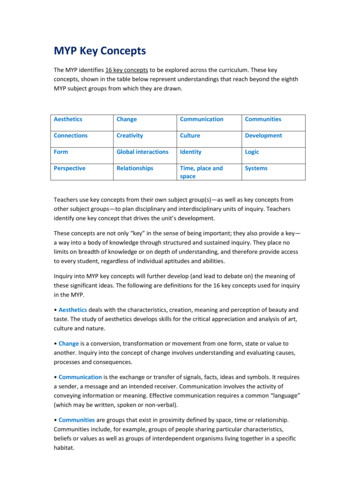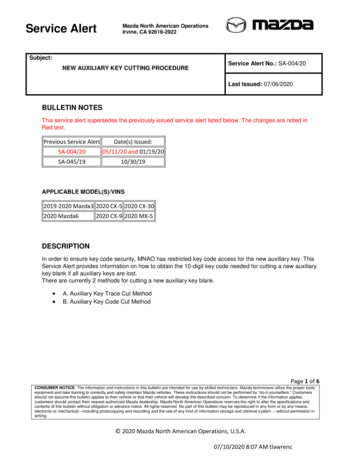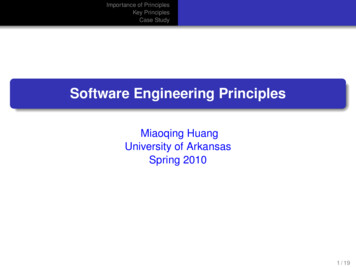
Transcription
Systems Change Principles:Key Concepts and SystemsChange DebateModule 2.2Joel Cutcher-GershenfeldSenior Research Scientist, MIT Sloan School of Management andExecutive Director, MIT Engineering Systems Learning CenterPresentation for:ESD.60 – Lean/Six Sigma SystemsMIT Leaders for Manufacturing Program (LFM)Summer 2004These materials were developed as part of MIT's ESD.60 course on "Lean/Six Sigma Systems." In some cases,the materials were produced by the lead instructor, Joel Cutcher-Gershenfeld, and in some cases by student teamsworking with LFM alumni/ae. Where the materials were developed by student teams, additional inputs from thefaculty and from the technical instructor, Chris Musso, are reflected in some of the text or in an appendix
Overview¾ Learning Objectives¾ Build capability in conductinga stakeholder analysis¾ Consider the role ofOrganizational Development(OD) in lean implementation¾ Consider alternative modelsfor systems change¾ Appreciation for the dilemmasand challenges in leanimplementation – contrasting“top down” and “bottom up”strategies¾ Session Design (20-30min.)¾ Part I: Introduction andLearning Objectives (1-2min.)¾ Part II: Key Concepts orPrinciples Defined andExplained (7-10 min.)¾ Part III: Exercise or ActivityBased on Field Data thatIllustrates the Concept orPrinciple (7-10 min.)¾ Parts IV-V: Common“Disconnects,” Metrics andConcluding Comments (2-3min.) Joel Cutcher-Gershenfeld – ESD.60 Lean/Six Sigma Systems, LFM, MITPart I: IntroductionPart II: ConceptsPart III: Application6/9/04 -- 2Part IV: DisconnectsPart V: Conclusion
Stakeholder Analysis¾ Small groups¾ Brainstorm a list of stakeholders for the Single-Point Modulesthat we will be developing¾ Identify 2-3 core interests of each stakeholder¾ Analyze overall areas of common interest and potential areas oftension or conflicting interest¾ Full group¾ What are the implications of your analysis?¾ What does this tell us about the nature of stakeholders andinterests? Joel Cutcher-Gershenfeld – ESD.60 Lean/Six Sigma Systems, LFM, MITPart I: IntroductionPart II: ConceptsPart III: Application6/9/04 -- 3Part IV: DisconnectsPart V: Conclusion
A Spectrum of OrganizationalDevelopment RolesBasic SkillsCompetentExpertMasterFacilitator . . . . . . . . . . . . . . . . . . . . . Process ExpertTrainer . . . . . . . . . . . . . . . . . . . . . .Trainer of TrainersMediator . . . . . . . . . . . . . Shuttle Diplomat“Thermometer”. . . . . . . . Moral/Ethical Sounding BoardStrategic Planner . . . . . . . . . . . . . . . . . Strategic VisionarySystems Thinker. . . . . . . . . . . . . . . . . . Systems DesignerOrganizational Assessor . . . . . . Organizational Architect Joel Cutcher-Gershenfeld – ESD.60 Lean/Six Sigma Systems, LFM, MITPart I: IntroductionPart II: ConceptsPart III: Application6/9/04 -- 4Part IV: DisconnectsPart V: Conclusion
Sample OD Wisdom¾ Resistance to change is not irrational¾ Training is not the solution to all problems¾ Disconnects are data¾ Leadership is necessary, but not sufficient¾ The big 3: Strategy, Structure, Process¾What are the implications for leanimplementation? Joel Cutcher-Gershenfeld – ESD.60 Lean/Six Sigma Systems, LFM, MITPart I: IntroductionPart II: ConceptsPart III: Application6/9/04 -- 5Part IV: DisconnectsPart V: Conclusion
Large-Scale Systems Change:A Five-Phase Process for Envisioning, Planning,Implementing and Sustaining Change5.0 Sustained Change4.0 Implementation3.0 Negotiated Change2.0 Shared Vision and Strategic Plan1.0 Stakeholders and Social Infrastructure Joel Cutcher-Gershenfeld – ESD.60 Lean/Six Sigma Systems, LFM, MITPart I: IntroductionPart II: ConceptsPart III: Application6/9/04 -- 6Part IV: DisconnectsPart V: Conclusion
Decomposition ofGeneric Implementation Model5.0 Sustained Change4.0 Implementation3.0 Negotiated Change2.0 Shared Vision and Strategic Plan1.0 Stakeholders and Social Infrastructure1.0 Stakeholders and SocialInfrastructure1.1 Identify stakeholders (including“communities of practice”) and analyzestakeholder interests (assuming a mixof common and competing interests)1.2 Form representativeDesign/Implementation Team(s) withidentified Champions from amongleaders in stakeholder groups(including reciprocal contracting withChampions)1.3 Identify existing forums andcommunication channels1.4 Identify missing or unstable forumsand communication channels (gaps inthe Social Infrastructure)1.5 Targeted chartering and othermechanisms to address gaps in theSocial Infrastructure2.0 Shared Vision and Strategic Plan2.1 Summarize Current State data/research (in apresentational format)2.2 Develop initial text of potential Shared Vision(facilitated with identified thought leaders) andincluding vision on substance and vision on thechange process2.3 Facilitate single or multiple stakeholder forums tocalibrate/adjust the draft Shared Vision2.4 Identify preliminary set of implementationmilestones, with associated resources andresponsibilities – to form a Strategic Plan2.5 Identify relevant metrics and feedback processes2.6 Calibrate/adjust Strategic Plan based on stakeholderinput and identify key domains for negotiations Joel Cutcher-Gershenfeld – ESD.60 Lean/Six Sigma Systems, LFM, MITPart I: IntroductionPart II: ConceptsPart III: Application6/9/04 -- 7Part IV: DisconnectsPart V: Conclusion
Decomposition ofGeneric Implementation Model (cont.)5.0 Sustained Change4.0 Implementation3.0 Negotiated Change2.0 Shared Vision and Strategic Plan1.0 Stakeholders and Social Infrastructure3.0 Negotiated Change4.0 Implementation (cont.)3.1 Build capability for interest-basedbargaining as appropriate3.2 Facilitate interest-based negotiationsamong key stakeholders – seekingmutual gains agreements withinbounds of regulatory and otherconstraints3.3 Ensure appropriate constituentratification or calibration of agreements3.4 Document and “error proof” formal andinformal agreements, anticipatingpotential “disconnects” inimplementation4.2 Utilize “Leader as Teacher”interventions to build capability andfoster commitment4.3 Track relevant metrics, open issues andother key data4.4 Anticipate “disconnects” inimplementation and ensure appropriatemechanisms to learn from thedisconnects in a non-blaming,constructive way4.0 Implementation5.1 Ongoing feedback, calibration, andincremental adjustment5.2 Hand-off mechanisms for leadershiptransitions5.3 Periodic review and renewal for moresubstantial adjustments4.1 Launch an appropriate mix of top-downrestructuring and bottom-upengagement across relevant forumsand channels for communications (witha continuing commitment to avoidsurprises)5.0 Sustained Change Joel Cutcher-Gershenfeld – ESD.60 Lean/Six Sigma Systems, LFM, MITPart I: IntroductionPart II: ConceptsPart III: Application6/9/04 -- 8Part IV: DisconnectsPart V: Conclusion
LaMarsh 4x3 “Managed Change” ModelA. Identify the Change1.1 ANALYZE THE CURRENT STATE1.2 DEFINE THE DESIRED STATE1.3 ASSESS THE DELTA STATEB. Prepare to Change2.12.22.33.13.23.3SPONSORSCHANGE AGENTSTARGETSCULTUREHISTORYRESISTANCEC. Plan the Change4.1 COMMUNICATIONS SYSTEM4.2 LEARNING SYSTEM4.3 REWARD SYSTEMD. Implement the Change:Build the Change Strategies and Tactics into an overall change planE. Monitor the Change:Watch, Measure and Adapt as the change is changingCourtesy of LaMarsh and Associates. Used with permission.Source: http://www.lamarsh.com Joel Cutcher-Gershenfeld – ESD.60 Lean/Six Sigma Systems, LFM, MITPart I: IntroductionPart II: ConceptsPart III: Application6/9/04 -- 9Part IV: DisconnectsPart V: Conclusion
Lean implementation strategiesTop-Down “Re-engineering”Bottom-up “Kaizen”¾ Many meanings:¾ Many meanings:¾ Range from a pretext forrestructuring and downsizing toa systematic review ofoperations with comprehensiveprocess mapping¾ Key quote:¾ “if it’s not broke, break it”¾ Roots in private and publicsectors, including “re-inventinggovernment”¾ First driven by economic crisisin 1980’s, now seen as aprocess for system change¾ GE “workout” process¾ Key quote:¾ “many small improvements buildlong-term transformation capability”¾ Roots:¾ Roots:¾ Archetypical Example:¾ Range from suggestion systems(kaizen-teian) to an underlyingphilosophy and a way of life¾ Post WWII Japan, beginning withquality circles (QC), statisticalprocess control (SPC), and just-intime (JIT) delivery practices¾ Increasingly seen from a systemsperspective -- Total QualityManagement (TQM), Six Sigma,Lean Enterprise¾ Archetypical Example:¾ Toyota Production System (TPS)“Kaizen event” – A contradiction in terms? Joel Cutcher-Gershenfeld – ESD.60 Lean/Six Sigma Systems, LFM, MITPart I: IntroductionPart II: ConceptsPart III: Application6/9/04 -- 10Part IV: DisconnectsPart V: Conclusion
Metrics, Disconnects, and ConcludingComments¾ What metrics can be used to track progress in the leanimplementation process?¾ What disconnects can be anticipated in managing achange process?¾ How important is the process as compared to thesubstance when it comes to lean implementation? Joel Cutcher-Gershenfeld – ESD.60 Lean/Six Sigma Systems, LFM, MITPart I: IntroductionPart II: ConceptsPart III: Application6/9/04 -- 11Part IV: DisconnectsPart V: Conclusion
Senior Research Scientist, MIT Sloan School of Management and Executive Director, MIT Engineering Systems Learning Center ESD.60 - Lean/Six Sigma Systems . LaMarsh 4x3 "Managed Change" Model A. Identify the Change B. C. Plan the Change D. E. Monitor the Change: Watch, Measure and Adapt as the change is changing

![Change Management Process For [Project Name] - West Virginia](/img/32/change-20management-20process-2003-2022-202012.jpg)








